Competition between Direct Detection Mechanisms in Planar Bow-Tie Microwave Diodes on the Base of InAlAs/InGaAs/InAlAs Heterostructures
Abstract
1. Introduction
2. Samples and Measurement Techniques
3. Results and Discussion
4. Conclusions
- The dc and high-frequency electrical properties of the bow-tie diodes, i.e., their electrical resistance and voltage sensitivity, were sensitive to the illumination of the diode with visible light.
- The voltage sensitivity of the diodes with the InAs inserts was more responsive to the illumination.
- When the bow-tie diodes with the InAs inserts with a typical lower voltage sensitivity were affected by the visible light, the polarity of the voltage detected across them changed from that of a thermoelectric electromotive force of hot carriers to the opposite one.
- The illumination increased the voltage sensitivity of the bow-tie diodes that had no InAs inserts.
- Analyses of the voltage–power characteristics, frequency dependence of the voltage sensitivity in the Ka frequency range, the temperature dependence of the detected voltage and the dynamics of the detected voltage through time allowed us to assume that the photo-gradient electromotive force arose in the bow-tie diodes under illumination.
- The visible-light-induced increase in the photo-gradient emf changed the polarity of the detected voltage in the bow-tie diodes with the InAs inserts and increased the magnitude of the detected voltage in the diodes without the inserts.
Author Contributions
Funding
Institutional Review Board Statement
Informed Consent Statement
Data Availability Statement
Acknowledgments
Conflicts of Interest
Appendix A
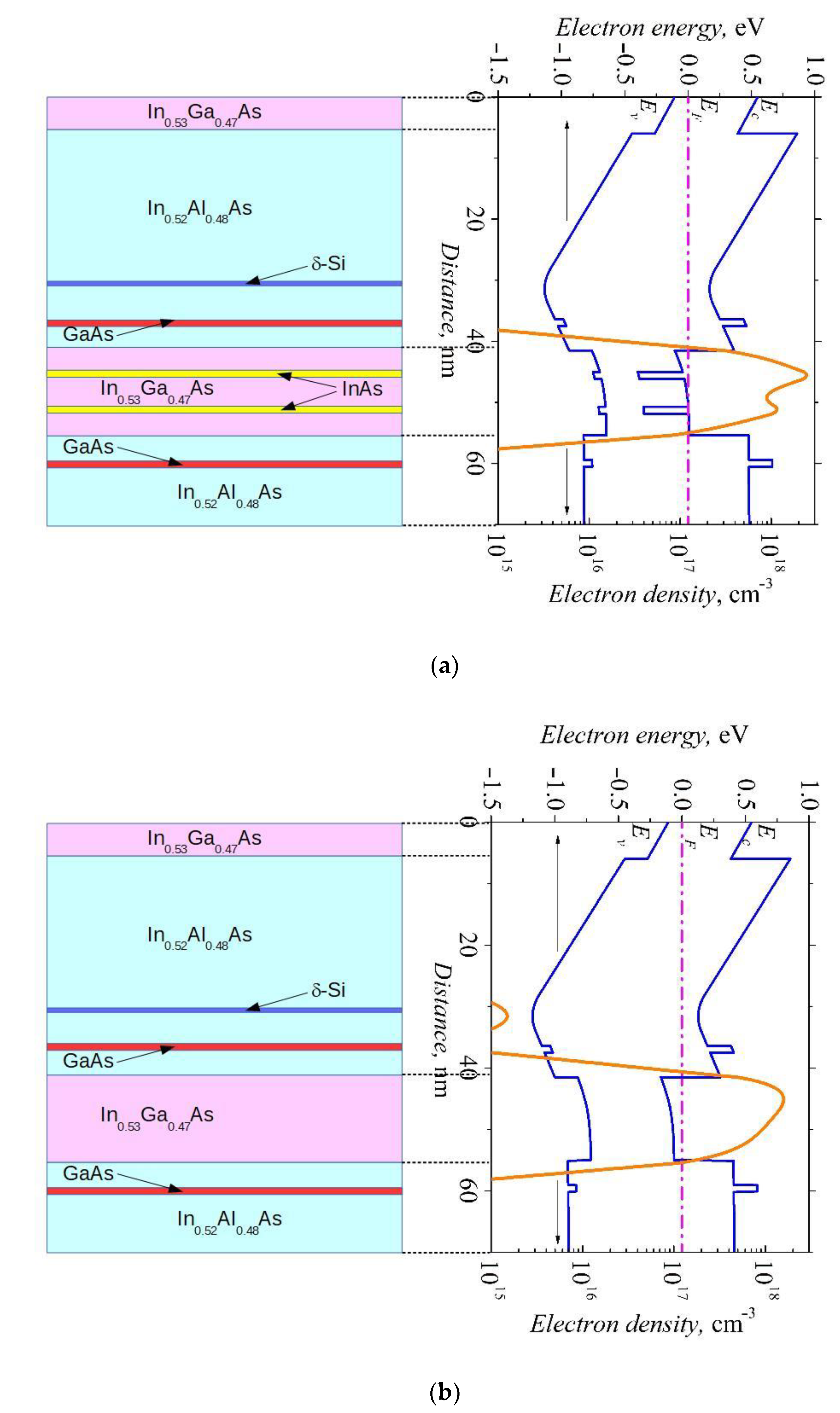
Appendix B
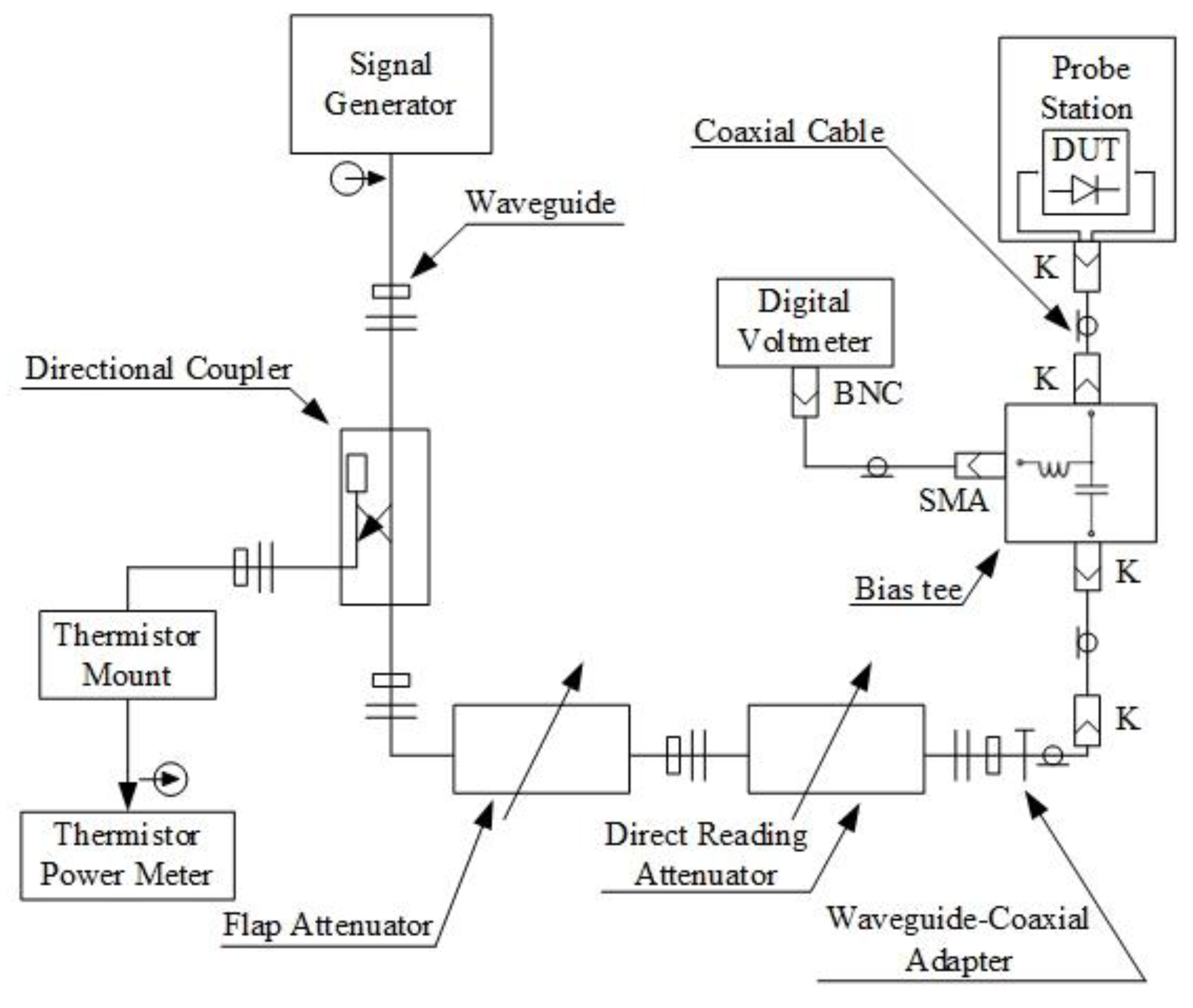
Appendix C
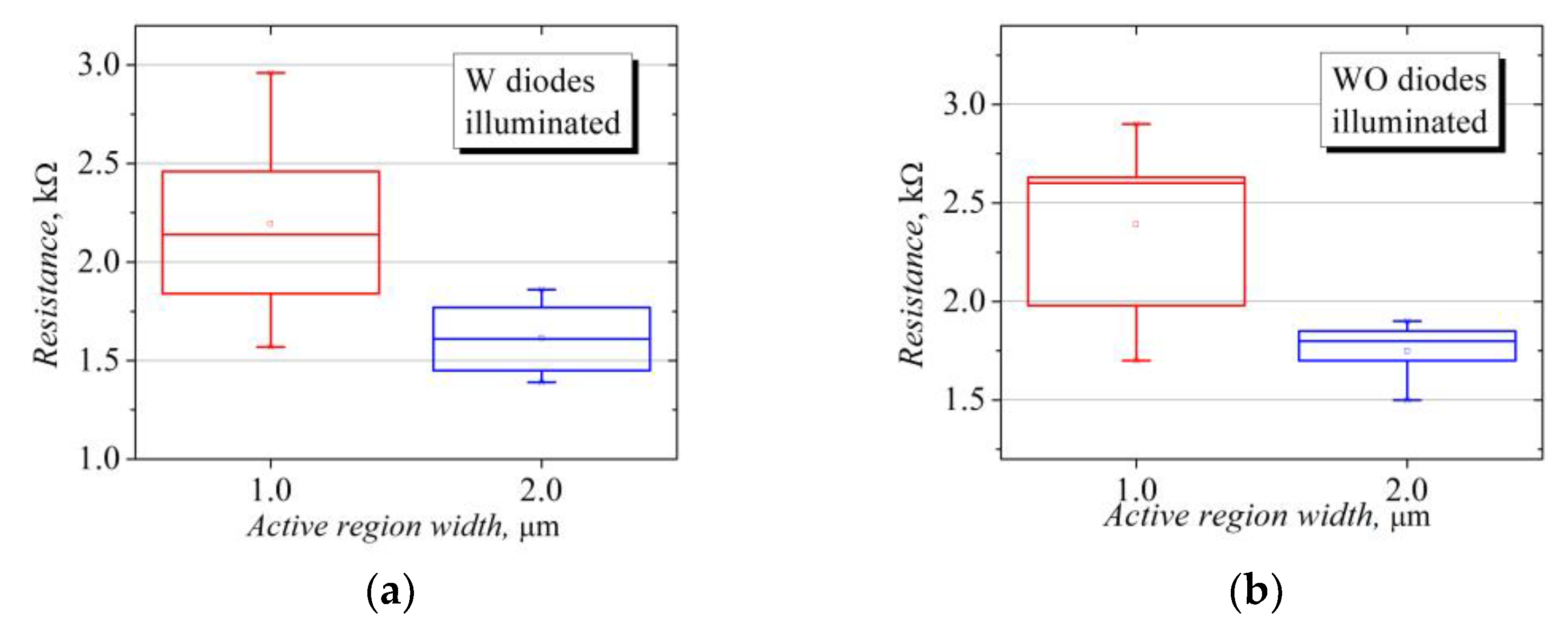
References
- Chan, W.L.; Deibel, J.; Mittleman, D.M. Imaging with terahertz radiation. Rep. Prog. Phys. 2007, 70, 1325–1379. [Google Scholar] [CrossRef]
- Yu, L.; Hao, L.; Meiqiong, T.; Jiaoqi, H.; Wei, L.; Jinying, D.; Xueping, C.; Weiling, F.; Yang, Z. The medical application of terahertz technology in non-invasive detection of cells and tissues: Opportunities and challenges. RSC Adv. 2019, 9, 9354–9363. [Google Scholar] [CrossRef]
- Petrov, V.; Pyattaev, A.; Moltchanov, D.; Koucheryavy, Y. Terahertz band communications: Applications, research challenges, and standardization activities. In Proceedings of the 2016 8th International Congress on Ultra Modern Telecommunications and Control Systems and Workshops (ICUMT), Lisbon, Portugal, 18–20 October 2016. [Google Scholar] [CrossRef]
- Siegel, P.H. Terahertz Technology. IEEE Trans. Microw. Theory Tech. 2002, 50, 910–928. [Google Scholar] [CrossRef]
- Virginia Diodes, Inc. Zero Bias Detector. Available online: https://www.vadiodes.com/en/products/detectors (accessed on 5 July 2022).
- Teppe, F.; Knap, W.; Veksler, D.; Shur, M.S.; Dmitriev, A.P.; Kachorovskii, V.Y.; Rumyantsev, S. Room-temperature plasma waves resonant detection of sub-terahertz radiation by nanometer field-effect transistor. Appl. Phys. Lett. 2005, 87, 052107. [Google Scholar] [CrossRef]
- Tauk, R.; Teppe, F.; Boubanga, S.; Coquillat, D.; Knap, W.; Meziani, Y.M.; Gallon, C.; Boeuf, F.; Skotnicki, T.; Fenouillet-Beranger, C.; et al. Plasma wave detection of terahertz radiation by silicon field effects transistors: Responsivity and noise equivalent power. Appl. Phys. Lett. 2006, 89, 253511. [Google Scholar] [CrossRef]
- Spirito, D.; Coquillat, D.; De Bonis, S.L.; Lombardo, A.; Bruna, M.; Ferrari, A.C.; Pellegrini, V.; Tredicucci, A.; Knap, W.; Vitiello, M.S. High performance bilayer-graphene terahertz detectors. Appl. Phys. Lett. 2014, 104, 061111. [Google Scholar] [CrossRef]
- Vitiello, M.S.; Viti, L.; Romeo, L.; Ercolani, D.; Scalari, G.; Faist, J.; Beltram, F.; Sorba, L.; Tredicucci, A. Semiconductor nanowires for highly sensitive, room-temperature detection of terahertz quantum cascade laser emission. Appl. Phys. Lett. 2012, 100, 241101. [Google Scholar] [CrossRef]
- Vitiello, M.S.; Viti, L.; Coquillat, D.; Knap, W.; Ercolani, D.; Sorba, L. One dimensional semiconductor nanostructures: An effective active-material for terahertz detection. APL Mater. 2015, 3, 026104. [Google Scholar] [CrossRef]
- Song, A.M.; Lorke, A.; Kriele, A.; Kotthaus, J.P.; Wegscheider, W.; Bichler, M. Nonlinear Electron Transport in an Asymmetric Microjunction: A Ballistic Rectifier. Phys. Rev. Lett. 1998, 80, 3831–3834. [Google Scholar] [CrossRef]
- Song, A.M.; Omling, P.; Samuelson, L.; Seifert, W.; Shorubalko, I.; Zirath, H. Operation of InGaAs/InP-Based Ballistic Rectifiers at Room Temperature and Frequencies up to 50 GHz. Jpn. J. Appl. Phys. 2001, 40, L909–L911. [Google Scholar] [CrossRef]
- Auton, G.; But, D.B.; Zhang, J.; Hill, E.; Coquillat, D.; Consejo, C.; Nouvel, P.; Knap, W.; Varani, L.; Teppe, F.; et al. Terahertz Detection and Imaging Using Graphene Ballistic Rectifiers. Nano Lett. 2017, 17, 7015–7020. [Google Scholar] [CrossRef]
- But, D.B.; Consejo, C.; Coquillat, D.; Teppe, F.; Knap, W.; Varani, L.; Torres, J.; Auton, G.; Zhang, J.; Hill, E.; et al. Millimeter and submillimeter range detector based on Graphene Ballistic Rectifiers. In Proceedings of the Microwave and Radar Week (MRW 2018), Poznań, Poland, 14–17 May 2018. [Google Scholar] [CrossRef]
- Song, A.M.; Missous, M.; Omling, P.; Peaker, A.R.; Samuelson, L.; Seifert, W. Unidirectional electron flow in a nanometer-scale semiconductor channel: A self-switching device. Appl. Phys. Lett. 2003, 83, 1881–1883. [Google Scholar] [CrossRef]
- Balocco, C.; Song, A.M.; Åberg, M.; Forchel, A.; González, T.; Mateos, J.; Maximov, I.; Missous, M.; Rezazadeh, A.A.; Saijets, J.; et al. Microwave Detection at 110 GHz by Nanowires with Broken Symmetry. Nano Lett. 2005, 5, 1423–1427. [Google Scholar] [CrossRef]
- Sangaré, P.; Ducournau, G.; Grimbert, B.; Brandli, V.; Faucher, M.; Gaquière, C.; Íñiguez-de-la-Torre, A.; Íñiguez-de-la-Torre, I.; Millithaler, J.F.; Mateos, J.; et al. Experimental demonstration of direct terahertz detection at room-temperature in AlGaN/GaN asymmetric nanochannels. J. Appl. Phys. 2013, 113, 034305. [Google Scholar] [CrossRef]
- Balocco, C.; Kasjoo, S.R.; Lu, X.F.; Linqing, Q.; Zhang, L.Q.; Alimi, Y.; Winnerl, S.; Aimin, M.; Song, A.M. Room-temperature operation of a unipolar nanodiode at terahertz frequencies. Appl. Phys. Lett. 2011, 98, 223501. [Google Scholar] [CrossRef]
- Westlund, A.; Winters, M.; Ivanov, I.G.; Hassan, J.; Nilsson, P.-Å.; Janzén, E.; Rorsman, N.; Grahn, J. Graphene self-switching diodes as zero-bias microwave detectors. Appl. Phys. Lett. 2015, 106, 093116. [Google Scholar] [CrossRef]
- Zhang, J.; Brownless, J.; Song, A. Graphene bridge rectifier based on self-switching diode arrays. Nanotechnology 2019, 30, 364004. [Google Scholar] [CrossRef]
- Ašmontas, S. Study of Electron Heating by Nonuniform Electric Fields in n-Si. Phys. Stat. Sol. (a) 1975, 31, 409–414. [Google Scholar] [CrossRef]
- Ašmontas, S. Electrogradient Phenomena in Semiconductors; Mokslas: Vilnius, Lithuania, 1984; 184p. (In Russian) [Google Scholar]
- Ašmontas, S.; Sužiedėlis, A. New Microwave Detector. Int. J. Infrared Millim. Waves 1994, 15, 525–537. [Google Scholar] [CrossRef]
- Eom, S.-H.; Seo, Y.; Lim, S. Pattern Switchable Antenna System Using Inkjet-Printed Directional Bow-Tie for Bi-Direction Sensing Applications. Sensors 2015, 15, 31171–31179. [Google Scholar] [CrossRef]
- Brunetti, G.; Sasanelli, N.; Armenise, M.N.; Ciminelli, C. Nanoscale Optical Trapping by Means of Dielectric Bowtie. Photonics 2022, 9, 425. [Google Scholar] [CrossRef]
- Sužiedėlis, A.; Gradauskas, J.; Ašmontas, S.; Valušis, G.; Roskos, H.G. Giga- and Terahertz Frequency Band Detector Based on an Asymmetrically necked n-n+-GaAs Planar Structure. J. Appl. Phys. 2003, 93, 3034–3038. [Google Scholar] [CrossRef]
- Juozapavičius, A.; Ardaravičius, L.; Sužiedelis, A.; Kozič, A.; Gradauskas, J.; Kundrotas, J.; Seliuta, D.; Širmulis, E.; Ašmontas, S.; Valušis, G. Microwave Sensor Based on Modulation-Doped GaAs/AlGaAs Structure. Semicond. Sci. Technol. 2004, 19, S436–S439. [Google Scholar] [CrossRef]
- Ašmontas, S.; Gradauskas, J.; Kozič, A.; Shtrikmann, H.; Sužiedėlis, A. Submicrometric Heavily Doped n-GaAs Structures for Microwave Detection. Acta Phys. Pol. A 2005, 107, 147–150. [Google Scholar] [CrossRef]
- Minkevičius, L.; Tamošiūnas, V.; Kašalynas, I.; Seliuta, D.; Valušis, G.; Lisauskas, A.; Boppel, S.; Roskos, H.G.; Köhler, K. Terahertz Heterodyne Imaging with InGaAs-Based Bow-Tie Diodes. Appl. Phys. Lett. 2011, 99, 131101. [Google Scholar] [CrossRef]
- Kašalynas, I.; Venckevičius, R.; Seliuta, D.; Grigelionis, I.; Valušis, G. InGaAs-Based Bow-Tie Diode for spectroscopic terahertz imaging. J. Appl. Phys. 2011, 110, 114505. [Google Scholar] [CrossRef]
- Jokubauskis, D.; Minkevičius, L.; Seliuta, D.; Kašalynas, I.; Valušis, G. Terahertz homodyne spectroscopic imaging of concealed low-absorbing objects. Opt. Eng. 2019, 58, 023104. [Google Scholar] [CrossRef]
- Ajayan, J.; Nirmal, D. A review of InP/InAlAs/InGaAs based transistors for high frequency applications. Superlattices Microstruct. 2015, 86, 1–19. [Google Scholar] [CrossRef]
- Dyakonova, N.; El Fatimy, A.; Łusakowski, J.; Knap, W.; Dyakonov, M.I.; Poisson, M.-A.; Morvan, E.; Bollaert, S.; Shchepetov, A.; Roelens, Y.; et al. Room-temperature terahertz emission from nanometer field-effect transistors. Appl. Phys. Lett. 2006, 88, 141906. [Google Scholar] [CrossRef]
- Stillman, W.J.; Shur, M.S. Closing the Gap: Plasma Wave Electronic Terahertz Detectors. J. Nanoelectron. Optoelectron. 2007, 2, 209–221. [Google Scholar] [CrossRef]
- Ridley, B.K. Electron scattering by confined LO polar phonons in a quantum well. Phys. Rev. B 1989, 39, 5282–5286. [Google Scholar] [CrossRef]
- Požela, J.; Jucienė, V.; Namajūnas, A.; Požela, K. Electron mobility and subband population tuning by a phonon wall inserted in a semiconductor quantum well. J. Appl. Phys. 1997, 81, 1775–1780. [Google Scholar] [CrossRef]
- Vasil’evskii, I.S.; Galieva, G.B.; Klimova, E.A.; Požela, K.; Požela, J.; Jucienė, V.; Sužiedėlis, A.; Žurauskienė, N.; Keršulis, S.; Stankevič, V. Electron Mobility and Drift Velocity in Selectively Doped InAlAs/InGaAs/InAlAs Heterostructures. Semiconductors 2011, 45, 1169–1172. [Google Scholar] [CrossRef]
- Sužiedėlis, A.; Ašmontas, S.; Gradauskas, J.; Čerškus, A.; Anbinderis, A. Indirect measurement of electron energy relaxation time at room temperature in two dimensional heterostructured semiconductors. Materials 2022, 15, 3224. [Google Scholar] [CrossRef]
- Williams, R. Modern GaAs Processing Methods, 2nd ed.; Artech House: Norwood, MA, USA, 1990; 437p. [Google Scholar]
- Anbinderis, M. Investigation of Detection Properties of Planar Microwave Diodes Based on A3B5 Semiconductor Compounds in Millimeter-Wavelength Range. Ph.D. Thesis, Vilnius Gediminas Technical University, Vilnius, Lithuania, 2023. Available online: http://dspace.vgtu.lt/handle/1/4340 (accessed on 18 January 2023).
- Ašmontas, S.; Gradauskas, J.; Kundrotas, J.; Sužiedėlis, A.; Šilėnas, A.; Valušis, G. Influence of Composition in GaAs/AlGaAs Heterojunctions on Microwave Detection. Mater. Sci. Forum 1998, 297–298, 319–322. [Google Scholar] [CrossRef]
- Matsuoka, T.; Kobayashi, E.; Taniguchi, K.; Hamaguchi, C.; Sasa, S. Temperature Dependence of Electron Mobility in InGaAs/InAlAs Heterostructures. Jap. J. Appl. Phys. 1990, 29, 2017–2025. [Google Scholar] [CrossRef]
- Vainberg, V.V.; Pylypchuk, A.S.; Baidus, N.V.; Zvonkov, B.N. Electron mobility in the GaAs/InGaAs/GaAs quantum wells. Semicond. Phys. Quantum Electron. Optoelectron. 2013, 16, 152–161. Available online: http://journal-spqeo.org.ua/n2_2013/v16n2-2013-p152-161.pdf (accessed on 27 January 2023). [CrossRef]
- Ašmontas, S.; Anbinderis, M.; Čerškus, A.; Gradauskas, J.; Sužiedėlis, A.; Šilėnas, A.; Širmulis, E.; Umansky, V. Gated bow-tie diode for microwave to sub-terahertz detection. Sensors 2020, 20, 829. [Google Scholar] [CrossRef]
- Ašmontas, S.; Požela, J.; Repšas, K. The Photogradient, E.M.F. of Hot Carriers. Phys. Stat. Sol. (b) 1972, 51, 225–232. [Google Scholar] [CrossRef]
- Seeger, K. Semiconductor Physics, 9th ed.; Springer: Berlin/Heidelberg, Germany, 2004; 538p. [Google Scholar]

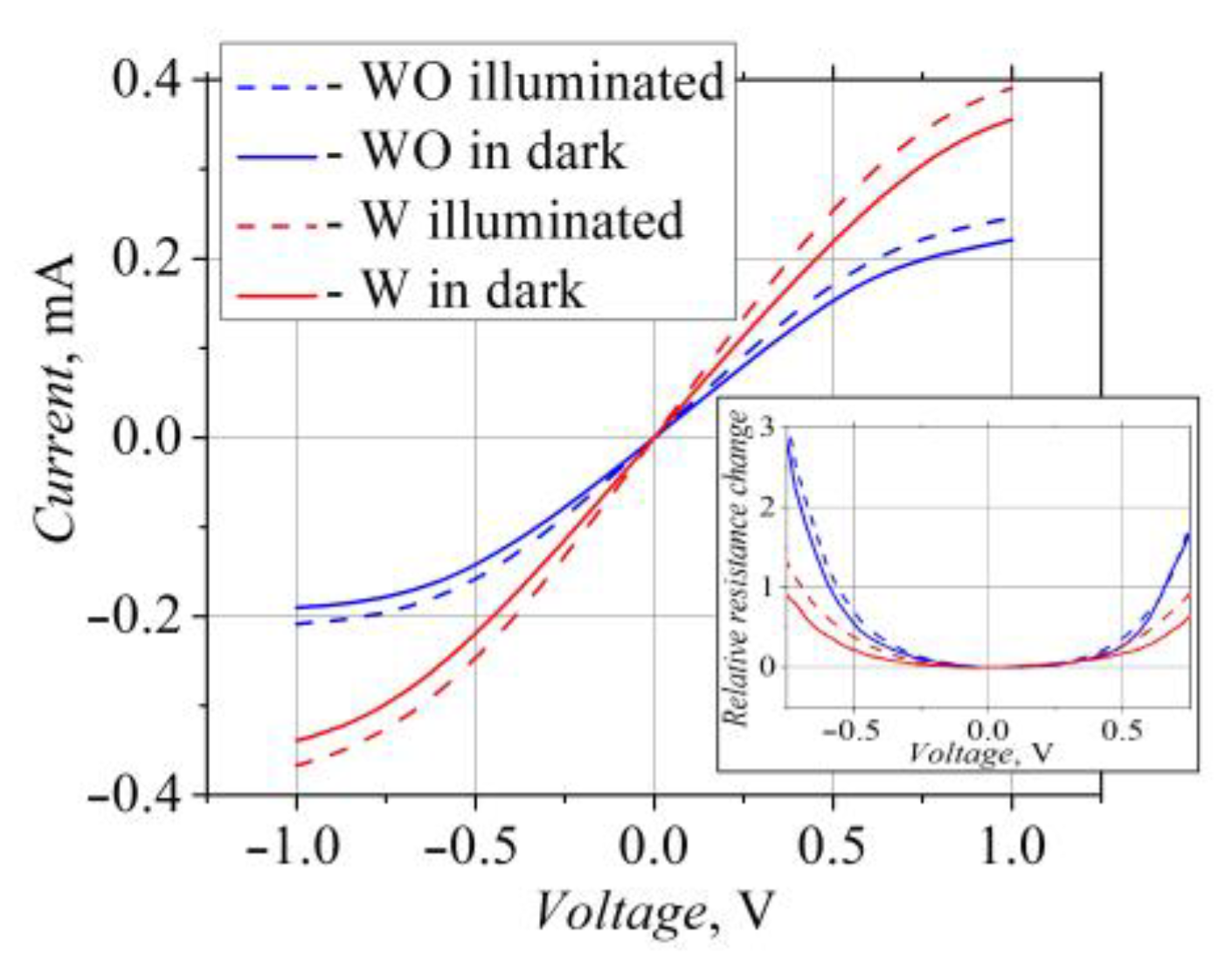



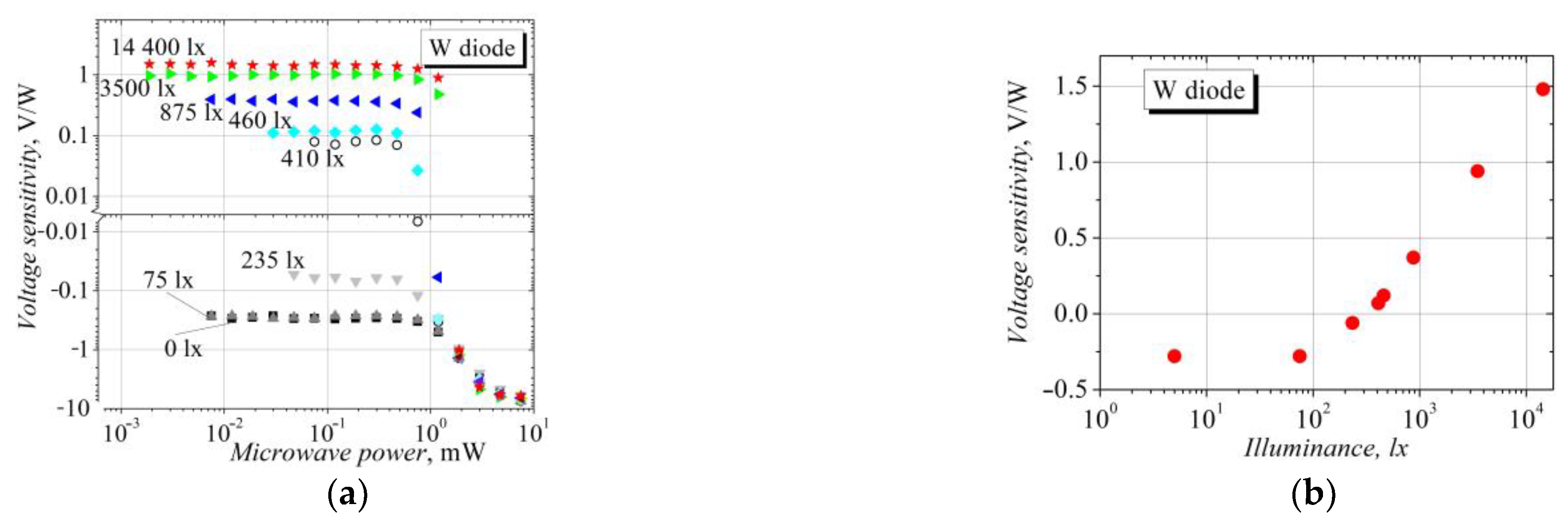



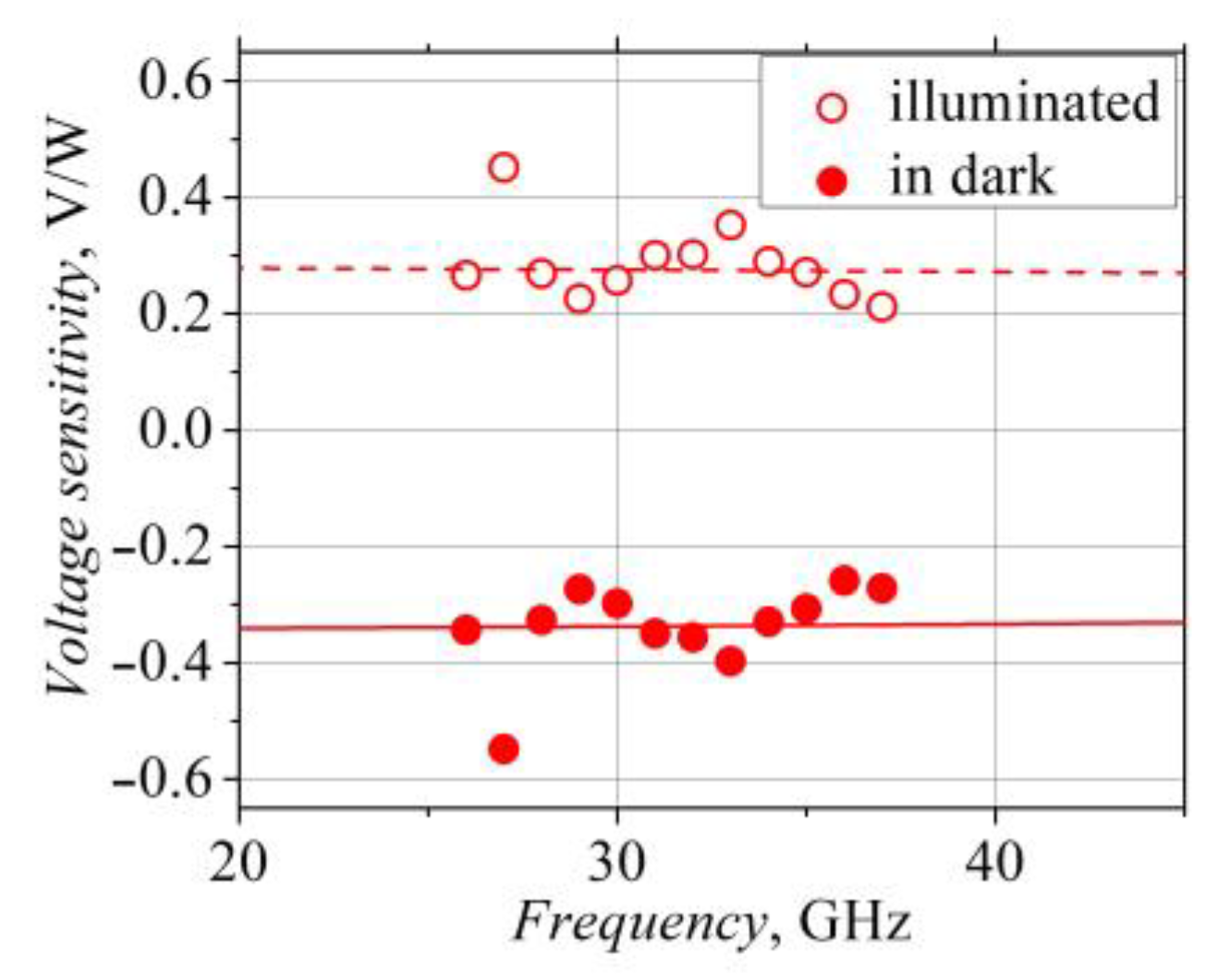

| Heterostructure | Sheet Density nsh, cm−2 | Electron Mobility μ, cm2/(V·s) | Sheet Resistance Rsh, Ω/☐ |
|---|---|---|---|
| W | 1.52 × 1012 | 7760 | 530 |
| WO | 1.39 × 1012 | 8390 | 536 |
| Bow-Tie Diodes on the Base of | In the Dark | Illuminated | ||
|---|---|---|---|---|
| ρc-d, Ω·mm | Rsh-d, Ω/☐ | ρc-ill, Ω·mm | Rsh-ill, Ω/☐ | |
| W heterostructure | 1.55 ± 1.01 | 530 ± 50 | 1.33 ± 0.77 | 462 ± 39 |
| WO heterostructure | 1.29 ± 0.60 | 542 ± 50 | 1.25 ± 0.64 | 479 ± 39 |
| Semiconductor Heterostructure | Width d, μm | Presumed Electrical Resistance, kΩ |
|---|---|---|
| W | 1 | 1.54 ÷ 3.08 |
| 2 | 1.12 ÷ 1.89 | |
| WO | 1 | 1.62 ÷ 2.90 |
| 2 | 1.17 ÷ 1.81 |
Disclaimer/Publisher’s Note: The statements, opinions and data contained in all publications are solely those of the individual author(s) and contributor(s) and not of MDPI and/or the editor(s). MDPI and/or the editor(s) disclaim responsibility for any injury to people or property resulting from any ideas, methods, instructions or products referred to in the content. |
© 2023 by the authors. Licensee MDPI, Basel, Switzerland. This article is an open access article distributed under the terms and conditions of the Creative Commons Attribution (CC BY) license (https://creativecommons.org/licenses/by/4.0/).
Share and Cite
Sužiedėlis, A.; Ašmontas, S.; Gradauskas, J.; Čerškus, A.; Požela, K.; Anbinderis, M. Competition between Direct Detection Mechanisms in Planar Bow-Tie Microwave Diodes on the Base of InAlAs/InGaAs/InAlAs Heterostructures. Sensors 2023, 23, 1441. https://doi.org/10.3390/s23031441
Sužiedėlis A, Ašmontas S, Gradauskas J, Čerškus A, Požela K, Anbinderis M. Competition between Direct Detection Mechanisms in Planar Bow-Tie Microwave Diodes on the Base of InAlAs/InGaAs/InAlAs Heterostructures. Sensors. 2023; 23(3):1441. https://doi.org/10.3390/s23031441
Chicago/Turabian StyleSužiedėlis, Algirdas, Steponas Ašmontas, Jonas Gradauskas, Aurimas Čerškus, Karolis Požela, and Maksimas Anbinderis. 2023. "Competition between Direct Detection Mechanisms in Planar Bow-Tie Microwave Diodes on the Base of InAlAs/InGaAs/InAlAs Heterostructures" Sensors 23, no. 3: 1441. https://doi.org/10.3390/s23031441
APA StyleSužiedėlis, A., Ašmontas, S., Gradauskas, J., Čerškus, A., Požela, K., & Anbinderis, M. (2023). Competition between Direct Detection Mechanisms in Planar Bow-Tie Microwave Diodes on the Base of InAlAs/InGaAs/InAlAs Heterostructures. Sensors, 23(3), 1441. https://doi.org/10.3390/s23031441







